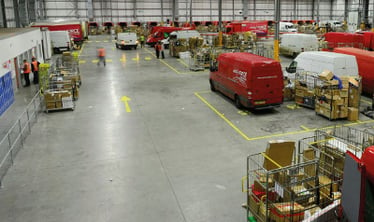 Problem
Problem
Controlling diesel engine exhaust emissions in enclosed spaces such as maintenance workshops is easily done with local exhaust ventilation (LEV), which can be as simple as fitting pipes to the vehicles’ exhausts while they are being serviced in order to draw the fumes outside. However, there are situations where this is not an option, for example in a warehouse where there is heavy vehicle movement inside the building, as vans and lorries come in and out for loading and unloading.
There are important considerations you will need to make about ventilation to ensure good air quality. Approved Document F (ADF) stipulates that sufficient ventilation must be provided to enclosed car parks to avoid an excessive build-up of carbon monoxide (CO).
However, the standard prescriptive solutions in Approved Document F for exhaust emissions do not take into account the variations in the levels of diesel exhaust in the air at different times. Colt offer expertise and can design outside-of-the-box approaches that are effective, and significantly cheaper than the standard, prescriptive solutions.
Process
We regularly work with consultant engineers and architects on the design of ventilation systems for distribution centres and maintenance workshops that are required to have a fume ventilation system to control exhaust emissions from the delivery vans.
For example, Royal Mail’s Parcelforce sorting and distribution centres required a fume ventilation system to control exhaust emissions from the delivery vans. These centres are converted warehouses and can contain up to 150 vans at any one time, all entering and exiting the building at similar times.
Unlike the standard Approved Document F prescription that would mean 6 air changes per hour, we recognised that there would be peaks at the times vans drive in or out: levels would go down when they were stationary while loading or unloading the parcels, or when the building was empty between rounds of deliveries and collections.
In situations like this one, where LEV is not possible, finding an effective and cost-efficient solution may require a little thinking outside the box. The first step is to analyse the layout of the building, its use, vehicle movements, and the size and type of the vehicles’ engines (from which you can calculate their emissions levels).
Colt’s early involvement with the customer enabled us to support the M&E consultant from initial design through to approval with building control. Royal Mail were able to tell us when and how the van movements occurred with specifics in terms of roadways and bay layouts, which allowed us to tailor the design.
Solution
This type of facility is usually unheated. This is an important consideration, as exhaust fumes are relatively hot, so will tend to rise, but in an unheated space they will cool as they rise and may not reach the roof extracts, requiring low and high level extract grilles. Monitoring the air quality and linking CO detection to the ventilation system can add a further level of efficiency, matching the extraction rates to the actual levels of emissions in the air at any time.
We developed a system which achieved cross flow ventilation via natural inlet air and mechanical extract with a combination of axial fans and natural ventilators. These are triggered by CO detectors when emissions levels reach a pre-determined level. This means that mechanical extraction fans only operate when needed, significantly cutting operating costs.
This cost-effective and bespoke solution was only possible due to Colt’s early involvement, from the initial design process and our close cooperation with the M&E consultant. So, if you are in a situation where LEV won’t do and need help with designing a bespoke solution, it is a good idea to involve the experts from the very early stages of your project.
